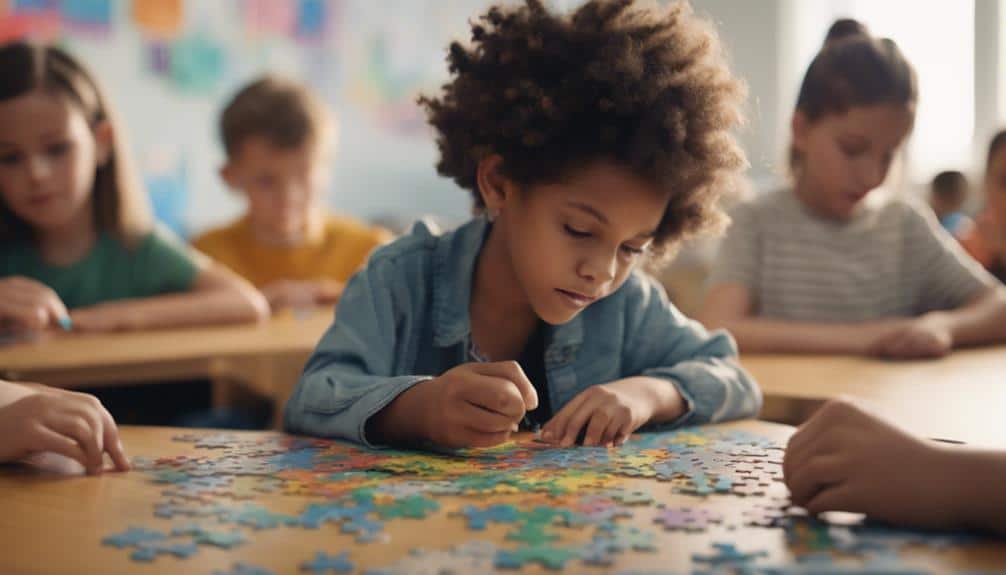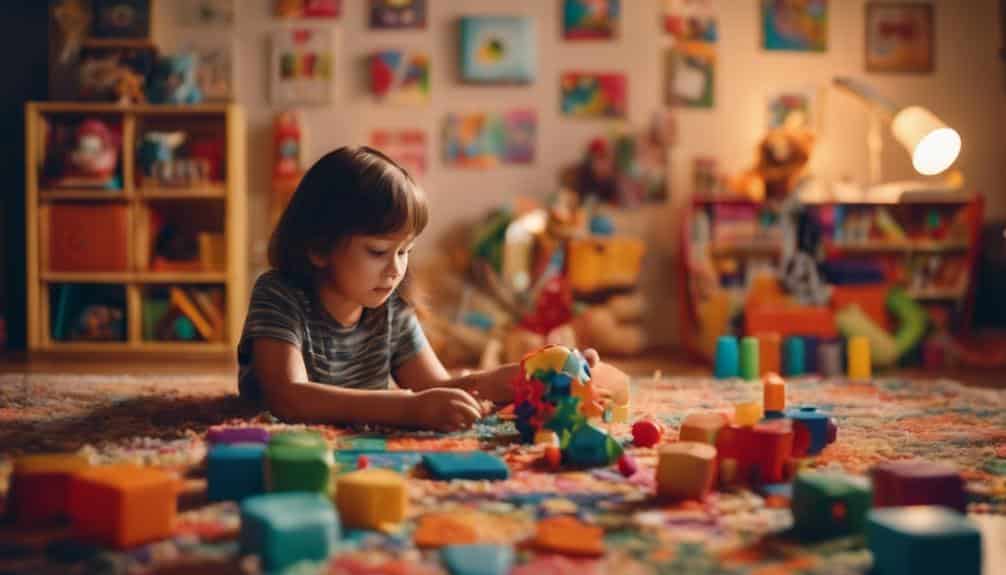The pivotal role of visual perception in children's academic success cannot be overstated, given its direct influence on crucial cognitive abilities necessary for learning. Challenges in visual perception can significantly impede a child's capacity to grasp reading, mathematics, and broader comprehension skills, thereby affecting their academic trajectory. The early identification of these issues, coupled with the implementation of targeted activities and interventions, holds the potential to markedly enhance a child's academic performance and cognitive development. As we explore the fundamental principles of optimizing visual perception, we invite educators, parents, and specialists to consider the transformative impact of tailored strategies and supportive environments on a child's educational journey.
Key Takeaways
- Improving visual perception enhances reading, writing, and problem-solving skills.
- A clutter-free, organized learning environment supports better visual focus.
- Multisensory techniques and visual aids are crucial for effective learning.
- Collaboration with educators and specialists tailors support for individual needs.
Understanding Visual Perception
Understanding visual perception is pivotal, as it encompasses the intricate processes of sensory processing, attention, discrimination, memory, and spatial relationships that are foundational for interpreting and responding to visual stimuli, which are critical for a child's academic achievement and overall development. This complex ability allows children to recognize and differentiate between letters, numbers, shapes, and to understand spatial concepts, which are essential skills for reading, mathematics, and other cognitive activities. Challenges in visual perceptual skills can manifest as difficulties with visual tasks, such as recognizing patterns or completing puzzles, which are not only pivotal for academic success but also for effective daily functioning.
Enhancing a child's visual perception can be achieved through targeted activities designed to improve these skills. Incorporating memory games, puzzles, and construction tasks into a child's learning regimen can significantly bolster their visual perceptual skills. These activities not only offer an engaging way to strengthen the necessary abilities for academic performance but also support the child's overall development and readiness for future learning challenges. Understanding and addressing the complexities of visual perception is therefore a crucial step in fostering a supportive environment that promotes every child's potential for academic success and lifelong learning.
Key OT Techniques Explored
Exploring key occupational therapy (OT) techniques reveals a range of targeted interventions designed to enhance visual perception skills in children, thereby supporting their academic achievements and cognitive development. These strategies are meticulously developed to address specific perceptual challenges that can hinder a child's learning process, focusing on improving visual acuity and perceptual skills necessary for academic success.
- Visual Discrimination: This technique aids children in recognizing subtle differences between objects, which is essential for reading, writing, and math.
- Memory Enhancement: Through activities aimed at boosting sequential memory, children learn to remember and sequence information, a skill critical for understanding and remembering instructions.
- Form Constancy: This intervention helps children understand that objects are the same in various environments, sizes, or positions, supporting skills like recognizing letters and numbers irrespective of font or case.
- Figure-Ground Perception: Enhancing this skill allows children to distinguish objects from their background, improving focus and attention in busy or detailed worksheets.
Implementing these OT strategies not only facilitates a child's ability to process visual information more effectively but also contributes to improved academic performance, attention, self-regulation, and a reduction in behavioral issues related to visual perception difficulties.
Activities to Enhance Visual Skills

Engaging children in specific activities, such as dot-to-dot worksheets and puzzles, can significantly enhance their visual sequential memory, contributing to their academic growth and cognitive development. These activities, grounded in evidence-based practices, underscore how perceptual skills are vital for interpreting and understanding visual information. Hidden pictures games, for instance, sharpen visual discrimination skills, allowing children to distinguish between similar objects, a foundational skill for reading and math. Memory games, by strengthening visual memory, enable better recall of information, crucial for academic success and effective learning strategies.
Incorporating construction-type activities like Lego into playtime or therapy sessions not only entertains but also develops visual spatial relationships and form constancy, skills that are fundamental for geometry and understanding the physical world around us. Additionally, the use of directional arrows can provide clear guidance, improving visual figure-ground perception, which helps children focus on specific information amidst a cluttered or busy background.
These activities, beneficial for both home and educational settings, align with strategies used in occupational therapy and speech, emphasizing a holistic approach to enhancing visual skills. By transforming even the bedroom floor into a learning environment, caregivers and educators can create opportunities for perceptual growth, essential for navigating both academic challenges and daily life.
Assessing Progress Over Time
After highlighting activities to enhance visual skills, it is crucial to focus on methods for assessing progress over time to ensure these interventions are effectively supporting children's academic and cognitive development. Regular, evidence-based assessments are pivotal in tracking the development of visual perception skills, which are foundational for academic success. Here are key approaches to monitoring progress:
- Utilizing standardized tools such as the Developmental Test of Visual Perception (DTVP-3) and Attention Network Test (ANT) to measure specific visual perceptual skills and attentional capabilities.
- Conducting longitudinal studies to gain insights into the developmental trajectory of visual perception skills in children, identifying patterns of improvement or areas requiring further support.
- Observing and documenting changes in critical areas such as visual discrimination, memory, form constancy, sequential memory, figure-ground perception, visual attention, and spatial relationships. These observations can highlight both progress and ongoing challenges.
- Tailoring educational strategies based on documented improvements in visual perception, ensuring interventions are aligned with each child's unique needs and are conducive to enhancing learning outcomes.
Through these methodologies, educators and therapists can effectively assess progress in visual perception, enabling them to implement targeted educational strategies that foster children's academic and cognitive growth.
Building a Supportive Environment

How can we create a supportive environment that optimizes visual perception for academic success in children? The development of visual perception is crucial, impacting every day skills essential for learning, such as reading, writing, and even tasks as simple as finding your sock. To foster an environment conducive to enhancing these skills, it's important to focus on organization and clarity in the child's learning space. A visually organized, clutter-free study area can significantly enhance focus and attention, especially for children with visual perception difficulties.
Utilizing visual aids like color-coded folders, labeled bins, and visual schedules not only aids in navigating tasks and routines but also supports effective learning by providing consistent and clear visual instructions. This reduces confusion and bolsters understanding in completing academic tasks. Further, incorporating multisensory learning activities that engage visual perception can be pivotal in supporting a child's academic journey. Lastly, collaboration with educators and specialists to tailor visual strategies ensures the learning environment is optimized for each child's unique needs. Such an evidence-based, child-focused approach is paramount in building a supportive environment that nurtures visual perception skills, paving the way for academic success.
Frequently Asked Questions
Why Is Visual Perception Important in Education?
Visual perception is vital in education as it underpins a child's ability to accurately recognize, interpret, and engage with visual stimuli, thereby significantly influencing their reading, writing, math skills, and overall cognitive development.
How Do You Help Students With Visual Perception?
To assist students with visual perception, integrating tools such as colored dots for discrimination and directional arrows for spatial orientation, alongside graph paper for word organization, significantly enhances their learning experience and academic performance.
Why Is so Important That a Child Has Visual Perception What Is It Used For?
Visual perception is critical in children for recognizing and differentiating objects, essential for reading, math, and other academic areas. It supports understanding spatial relationships, crucial for puzzles, math, and effective information processing and learning.
How Can I Help My Child With Visual Perception Problems?
To assist a child with visual perception difficulties, implement strategies such as providing visual cues, utilizing graph paper for alignment, breaking tasks into smaller steps, and engaging in memory and puzzle games. Professional guidance is also recommended.
Conclusion
In conclusion, the imperative of optimizing visual perception in children transcends mere academic success; it is the cornerstone of unlocking infinite potential within young minds. Through evidence-based interventions, targeted activities, and continuous assessment, children can overcome the invisible barriers that visual perception issues present. The creation of a supportive environment acts as the final piece in this intricate puzzle, ensuring every child has the opportunity to soar academically, akin to an eagle in boundless skies, unhindered by the chains of visual perception challenges.


Recent Comments